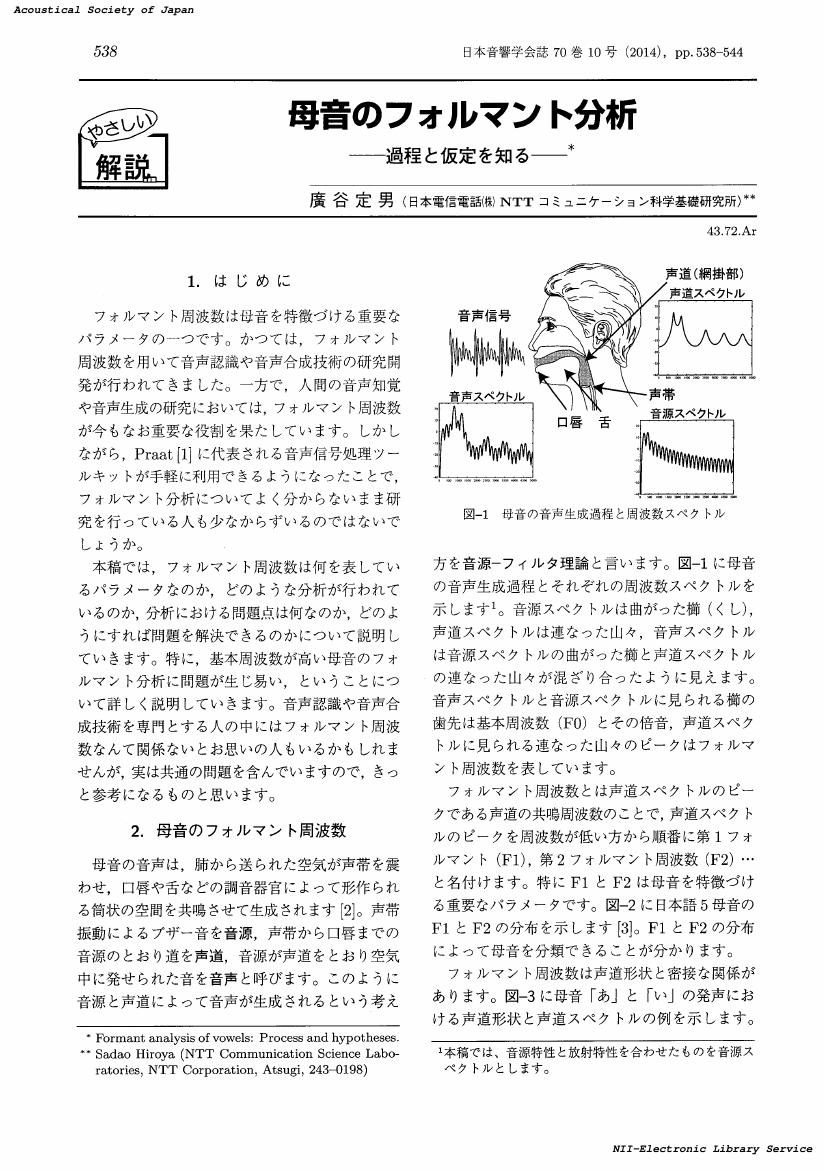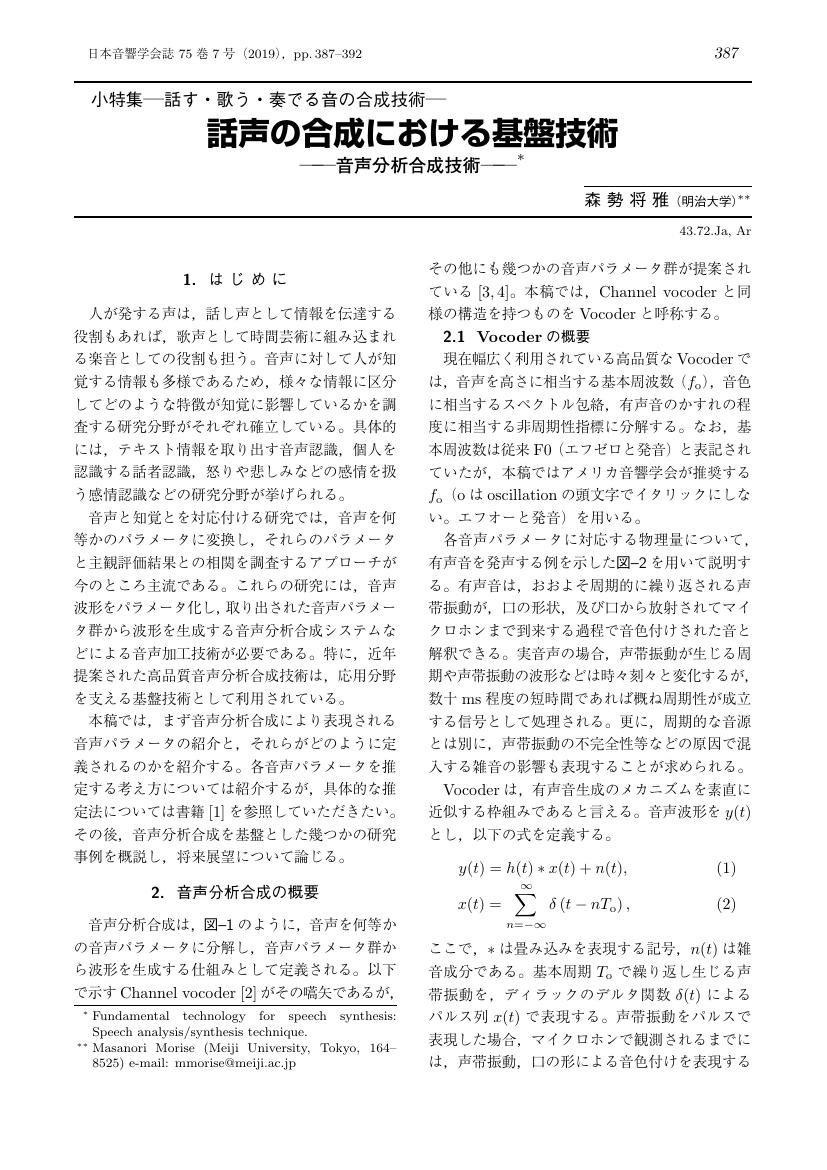3 0 0 0 OA 母音のフォルマント分析 : 過程と仮定を知る(やさしい解説)
- 著者
- 廣谷 定男
- 出版者
- 一般社団法人 日本音響学会
- 雑誌
- 日本音響学会誌 (ISSN:03694232)
- 巻号頁・発行日
- vol.70, no.10, pp.538-544, 2014-10-01 (Released:2017-06-02)
- 被引用文献数
- 1
3 0 0 0 OA 邦楽器の構造と音色 (<小特集>楽器の物理と音色)
- 著者
- 安藤 由典
- 出版者
- 一般社団法人 日本音響学会
- 雑誌
- 日本音響学会誌 (ISSN:03694232)
- 巻号頁・発行日
- vol.49, no.3, pp.208-215, 1993-03-01 (Released:2017-06-02)
- 参考文献数
- 17
3 0 0 0 OA クラシックギターにおける弾弦位置と異弦同音の違いが音色印象に与える影響
- 著者
- 志野 文音 丸井 淳史 亀川 徹
- 出版者
- 一般社団法人 日本音響学会
- 雑誌
- 日本音響学会誌 (ISSN:03694232)
- 巻号頁・発行日
- vol.75, no.1, pp.6-9, 2019-12-25 (Released:2019-07-01)
- 参考文献数
- 9
3 0 0 0 OA 口笛の科学 : 口笛の吹き方から口笛検定まで
- 著者
- 森 幹男
- 出版者
- 一般社団法人 日本音響学会
- 雑誌
- 日本音響学会誌 (ISSN:03694232)
- 巻号頁・発行日
- vol.67, no.12, pp.582-586, 2011-12-01 (Released:2017-06-02)
- 参考文献数
- 15
- 被引用文献数
- 1
3 0 0 0 OA 音楽情動研究の動向 : 歴史・計測・理論の視点から
- 著者
- 大村 英史 柴山 拓郎 寺澤 洋子 星(柴) 玲子 川上 愛 吹野 美和 岡ノ谷 一夫 古川 聖
- 出版者
- 一般社団法人 日本音響学会
- 雑誌
- 日本音響学会誌 (ISSN:03694232)
- 巻号頁・発行日
- vol.69, no.9, pp.467-478, 2013-09-01 (Released:2017-06-02)
本稿では,音楽情動に関わる研究を歴史,測定,心理的知見,生理的知見,理論の五つの項目から横断的に概観し,音楽の知覚と情動に関わるメカニズムについて考察を行う。従来の音楽情動の研究では,メロディやリズムなどの音に関する要素と情動の関係に焦点を当てた研究が中心であったが,最近では音楽が持つ背景や聴取環境などの音以外の要素と情動の関係の知見も多く報告されている。これらは,音楽情動を引き起こす原因が音に関する事象だけに存在しているのではなく,他の事象も多く存在することを示している。本稿ではこれらの事象をひとまとめにして,音楽と聴取者の間に存在する,音楽情動を引き起こすための「媒体」と呼ぶ。音楽情動に関係する複数の媒体は互いに影響を与え合い複雑な関係になっていることが考えられる。
3 0 0 0 OA 話声の合成における基盤技術 ——音声分析合成技術——
- 著者
- 森勢 将雅
- 出版者
- 一般社団法人 日本音響学会
- 雑誌
- 日本音響学会誌 (ISSN:03694232)
- 巻号頁・発行日
- vol.75, no.7, pp.387-392, 2019-07-01 (Released:2020-01-01)
- 参考文献数
- 35
3 0 0 0 OA 話声の合成における応用技術 ——DNNテキスト音声合成システム——
- 著者
- 高木 信二
- 出版者
- 一般社団法人 日本音響学会
- 雑誌
- 日本音響学会誌 (ISSN:03694232)
- 巻号頁・発行日
- vol.75, no.7, pp.393-399, 2019-07-01 (Released:2020-01-01)
- 参考文献数
- 61
3 0 0 0 OA 歌の声 : 声質の魅力と問題点(<小特集>音楽音響のニュー・フロンティア)
- 著者
- 中山 一郎 小林 範子
- 出版者
- 一般社団法人 日本音響学会
- 雑誌
- 日本音響学会誌 (ISSN:03694232)
- 巻号頁・発行日
- vol.52, no.5, pp.383-388, 1996-05-01 (Released:2017-06-02)
3 0 0 0 光マイクロホンを用いたMRI撮像時の騒音測定
- 著者
- 北村 達也 正木 信夫 島田 育廣 藤本 一郎 赤土 裕子 本多 清志
- 出版者
- 一般社団法人 日本音響学会
- 雑誌
- 日本音響学会誌 (ISSN:03694232)
- 巻号頁・発行日
- vol.62, no.5, pp.379-382, 2006
- 参考文献数
- 8
- 被引用文献数
- 13
MRI装置の普及と高磁場化に伴い,撮像時の騒音は無視できない問題となっている。しかし,装置内の騒音測定には磁性体を含む一般的な装置を利用することができない。また,強磁場下で利用可能な測定装置を使っても,その一部に導電体が含まれていればRFパルス(電磁波)に起因するノイズが混入する可能性がある。本研究では非導電体のみで構成された光マイクロホンを用いてこの問題を解決し,1.5TのMRI装置を対象にしてSpin-echo T1強調,Fast spin-echo T2強調,RF-FAST,及びSingle-shot EPIの4種の撮像シーケンスの騒音を測定した。その結果,これらの騒音の音圧レベルはそれぞれ112.6dB,112.5dB,107.8dB,110.6dBであった。
3 0 0 0 OA 共通語アクセントの成因分析
- 著者
- 佐藤 大和
- 出版者
- 一般社団法人 日本音響学会
- 雑誌
- 日本音響学会誌 (ISSN:03694232)
- 巻号頁・発行日
- vol.49, no.11, pp.775-784, 1993-11-01 (Released:2017-06-02)
- 参考文献数
- 13
共通語アクセントの統計的分析結果を報告する。「日本語アクセント」辞典に収録されている約6万語に、語の構造を示す境界記号を付し、計算機に入力して、単語長別、語種別(和語、漢語、外来語等)、及び語構造別にアクセント型を集計した。従来より、語尾から3番目のモーラに核を置くアクセント型(逆3型)が頻度の高い型であることが知られていたが、こうした逆3型などの中高型アクセントは、語の複合によって生じていることを語構造とアクセントの分析結果から明らかにする。また、日本語の基本語彙を構成する4モーラ以下の語に関して、語種別に頻度の高いアクセント型を示し、短い語から長い複合語に至るアクセント型の変遷を考察する。
3 0 0 0 OA 小区間の線形予測分析とその誤差評価
- 著者
- 河原 英紀 栃内 香次 永田 邦一
- 出版者
- 一般社団法人 日本音響学会
- 雑誌
- 日本音響学会誌 (ISSN:03694232)
- 巻号頁・発行日
- vol.33, no.9, pp.470-479, 1977-09-01 (Released:2017-06-02)
This paper describes a speech analysis method for linear predictor coefficients and formant frequencies and bandwidths estimation using a portion of one pitch period of speech waveform. This method is based on the fact that estimation errors together with prediction errors vanish when excitation-free segments are utilized (Eq. 6). In the case of actual speech analysis, however, prediction errors may remain, even if they are minimum (Fig. 1). Therefore, it is necessary to formulate estimation errors in order to evaluate the performance of the proposed method. Theoretical studies on estimation errors are carried out. Estimation errors in linear predictor coefficients are dependent on the unknown component of excitation (see Eqs. 7 through 11). Expected values of estimation errors are derived, based on the assumption of the statistical property of excitation (see Eqs. 13 through 15) . A similar expression of estimation errors in formant frequencies and bandwidths is derived in the same manner (see Eqs. 16 through 18). Finally, two kinds of error estimates represented in terms of observed values are introduced as criteria for the determination of analysis conditions of our method and for the experimental comparison between the proposed method and the usual linear predictive analysis (Eq. 19). Simulation studies on these error estimates are performed using several kinds of synthetic speech. Their formant frequencies and bandwidths are given in Table 1. The relevance of these error estimates is indicated in the case of our method and in the case of usual linear predictive analysis (Figs. 2 through 5 and Tables 2 and 3). The length of the analysis segment must be properly chosen when these error estimates are employed in the error evaluation of the usual linear predictive analysis of periodic speech (Eq. 20 and Fig. 6). The results of simulation studies indicate both adequacy and validity of these error estimates. Experimental studies have been done to evaluate the performance of our method in the case of actual speech analysis. The minimum values of these error estimates of our method are as small as one half to one eighth of those of usual linear predictive analysis (Figs. 7 through 9 and Tables 4 and 5). In addition, the glottal source waveform estimated by using the result of our method seems more plausible than that obtained by using the result of the usual linear predictive analysis (Fig. 10). The results of these studies indicate that the proposed method yields more accurate estimates of parameters than those obtained by the usual linear predictive analysis, especially in the case of low-pitched speech.
- 著者
- 岩谷 幸雄 岡本 拓磨 トレビーニョ ホルヘ 鈴木 陽一
- 出版者
- 一般社団法人 日本音響学会
- 雑誌
- 日本音響学会誌 (ISSN:03694232)
- 巻号頁・発行日
- vol.67, no.11, pp.544-549, 2011
- 参考文献数
- 22
- 著者
- 竹本 浩典
- 出版者
- 一般社団法人 日本音響学会
- 雑誌
- 日本音響学会誌 (ISSN:03694232)
- 巻号頁・発行日
- vol.70, no.9, pp.506-511, 2014-09-01 (Released:2017-06-02)
3 0 0 0 OA 音質評価のための7属性
- 著者
- 厨川 守 八尋 博司 柏木 成豪
- 出版者
- 一般社団法人 日本音響学会
- 雑誌
- 日本音響学会誌 (ISSN:03694232)
- 巻号頁・発行日
- vol.34, no.9, pp.493-500, 1978-09-01 (Released:2017-06-02)
As a result of determining a macroscopic structure of tone quality by sensory evaluations and multidimensional scaling method, it seemed that the psychological space applicable to tonal descriptive terms is composed of three main attributes, namely LOUDNESS(loud-sorf), PITCH(high pitched-low pitched) and PLEASANTNESS(pleasant-unpleasant) mutually almost orthogonal. Moreover, four sub-attributes intersecting obliquely to the three main-attributes were found. These sub-attributes included CONSONANCE (clear-turbid), BRIGHTNESS(bright-somber), RICHNESS (rich-thin) and SMOOTHNESS (smooth-rough). As a matter of fact, these four sub-attributes depend on the three main-attributes(Fig. 10). For example, the "clear" quality of consonance is "soft", "high pitched" and "pleasant" sound, while the "turbid" quality is "loud", "low pitched" and "unpleasant" sound, and this result thoroughly corresponds to the CONSONANCE THEORY. The tonal sources used for the present hearing experiments consist of four groups. They are (1) 57 synthetic tones the physical values of which are distinctly grasped, (2) 97 musical instrument solo tones, (3) 44 tones by varying a part of the sound of "Scheherazade", which is the orchestral music with dominant string sections, and (4) 33 tones by varying a part of "Pictures at an exhibition", which is the orchestral music with dominant percussion and brass sections. As for the variation of above mentioned two orchestral sources, the quantitative variations such as spectrum form, intensity, phase modulation and echo were given, 41-53 hearing panels evaluated these tones by the choise of 38 tonal descriptive terms(Table 1) in the auditorium. For analysis, the program by Kruskal was used. (Fig. 4). As the result of this analysis, configurations in Fig. 6〜9 were obtained in three dimensions for each two source groups(Table 3). As for the distribution of the terms for these four source groups, the words of praise and displeasure distributed in two semispherical shell space divided by LOUDNESS-PITCH plane. At the center of the two hemispheric configurations, "pleasant" and "unpleasant" distributed, which represent important factors. This axis was stable even if the sources are different, therefore, PLEASANTNESS is regarded as the third main attribute following LOUDNESS and PITCH(Table 4). Next, the stable terms distributing in the diagonal quadrants among eight quadrants in Fig. 6〜9 are closely examined in common in four source groups, then the terms of four sub-attributes described above were extracted. When the above experimental data were reanalyzed with 14 terms concerning three main attributes and four sub-attributes, the stress in three dimensions decreased further, and approximately similar configuration was obtained. Based on these facts, it is suggested that the fourteen tonal descriptive terms concerning three main-attributes and four sub-attributes are sufficient for deriving the macroscopic structure of tonal sources.
3 0 0 0 OA 音声に含まれる感情の認識(<小特集>音声は何を伝えているか)
- 著者
- 鈴木 基之
- 出版者
- 一般社団法人 日本音響学会
- 雑誌
- 日本音響学会誌 (ISSN:03694232)
- 巻号頁・発行日
- vol.71, no.9, pp.484-489, 2015-09-01 (Released:2017-06-02)
- 著者
- 矢野 隆 山田 一郎 吉野 泰子 五十嵐 寿一 加来 治郎 神田 一伸 金子 哲也 桑野 園子 新居 洋子 佐藤 哲身 荘 美知子
- 出版者
- 一般社団法人 日本音響学会
- 雑誌
- 音響学会誌 (ISSN:03694232)
- 巻号頁・発行日
- vol.58, no.3, pp.165-172, 2002
- 参考文献数
- 20
- 被引用文献数
- 4
ICBEN Team 6が提案する方法に従って種々の言語間で比較可能な騒音のうるささに関する5段階の尺度(「非常に」,「だいぶ」,「多少」,「それほど…ない」,「まったく…ない」)を構成した。この実験に用いた21の言葉や尺度に選ばれた五つの言葉が普段人々が騒音のうるささの程度を表すのによく使うかどうかを調査し,これらの言葉は人々がよく使うことを確認した。また,ICBEN Team 6が提案している騒音のうるささに関する英語の質問文とほぼ等価な日本語の質問文を作成した。その際,英語の質問文の翻訳・逆翻訳に関する調査結果及びうるささの概念に関する既往の研究結果を基に,英語の"bothers, disturbs or annoys"に相当する日本語として「悩まされる,あるいは,じゃまされる,うるさいと感じる」を当てることにした。
3 0 0 0 OA 小特集「頭部伝達関数とその応用」にあたって
- 著者
- 森本 政之
- 出版者
- 一般社団法人 日本音響学会
- 雑誌
- 日本音響学会誌 (ISSN:03694232)
- 巻号頁・発行日
- vol.73, no.3, pp.163-165, 2017-03-01 (Released:2017-09-01)
- 参考文献数
- 12
3 0 0 0 OA 頭部伝達関数の模擬によるヘッドホン再生音像の定位
- 著者
- 川浦 淳一 鈴木 陽一 浅野 太 曽根 敏夫
- 出版者
- 一般社団法人 日本音響学会
- 雑誌
- 日本音響学会誌 (ISSN:03694232)
- 巻号頁・発行日
- vol.45, no.10, pp.756-766, 1989-10-01 (Released:2017-06-02)
- 被引用文献数
- 3
本論文では、ヘッドホン再生によってラウドスピーカ再生時の音場を模擬する手法について述べる。ヘッドホン再生条件と、ラウドスピーカ再生条件の比較から、頭部が静止している状態の静的な頭部伝達関数と、聴取者が頭部を動かすことによって生じる頭部伝達関数の動的な変化の2点について、ディジタル信号処理などの手法により補償を行った。静的な頭部伝達だけの補償によって、ヘッドホン再生によっても、頭外の水平面内任意方向への音像定位が実現できたが、正面付近のラウドスピーカを模擬した場合には前後の誤判定が増加する、頭内定位が起き易いなどの問題が生じた。静的な頭部伝達関数に加えて、伝達関数の動的な変化を模擬すると、前後の誤判定が減少し、頭内定位も減少するなど、より自然な音像定位が実現された。また、頭部回転に伴う動的な音源位置情報は、静的な伝達関数からの音源位置情報に比べて、少なくとも同程度の重みを持つものであることが示唆された。
- 著者
- 佐藤 正之
- 出版者
- 一般社団法人 日本音響学会
- 雑誌
- 日本音響学会誌 (ISSN:03694232)
- 巻号頁・発行日
- vol.69, no.1, pp.24-27, 2012-12-25 (Released:2017-06-02)
- 参考文献数
- 2
- 著者
- 前島 正裕
- 出版者
- 一般社団法人日本音響学会
- 雑誌
- 日本音響学会誌 (ISSN:03694232)
- 巻号頁・発行日
- vol.65, no.2, 2009-02-01










